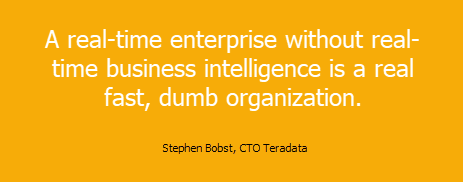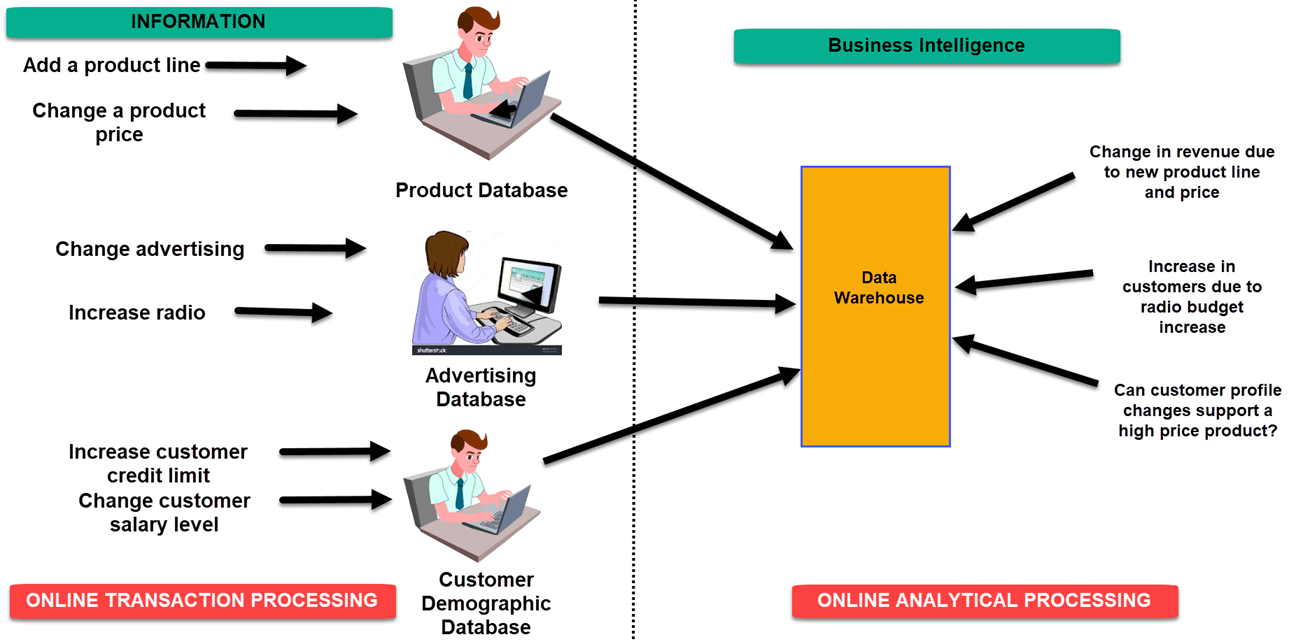What is Business Intelligence? BI Definition, Meaning & Example
What is Business Intelligence?
BI(Business Intelligence) is a set of processes, architectures, and technologies that convert raw data into meaningful information that drives profitable business actions. It is a suite of software and services to transform data into actionable intelligence and knowledge.
BI has a direct impact on organization’s strategic, tactical and operational business decisions. BI supports fact-based decision making using historical data rather than assumptions and gut feeling.
BI tools perform data analysis and create reports, summaries, dashboards, maps, graphs, and charts to provide users with detailed intelligence about the nature of the business.
Why is BI important?
- Measurement: creating KPI (Key Performance Indicators) based on historic data
- Identify and set benchmarks for varied processes.
- With BI systems organizations can identify market trends and spot business problems that need to be addressed.
- BI helps on data visualization that enhances the data quality and thereby the quality of decision making.
- BI systems can be used not just by enterprises but SME (Small and Medium Enterprises)
How Business Intelligence systems are implemented?
Here are the steps:
Step 1) Raw Data from corporate databases is extracted. The data could be spread across multiple systems heterogeneous systems.
Step 2) The data is cleaned and transformed into the data warehouse. The table can be linked, and data cubes are formed.
Step 3) Using BI system the user can ask quires, request ad-hoc reports or conduct any other analysis.
Examples of Business Intelligence System used in Practice
Example 1:
In an Online Transaction Processing (OLTP) system information that could be fed into product database could be
- add a product line
- change a product price
Correspondingly, in a Business Intelligence system query that would beexecuted for the product subject area could be did the addition of new product line or change in product price increase revenues
In an advertising database of OLTP system query that could be executed
- Changed in advertisement options
- Increase radio budget
Correspondigly, in BI system query that could be executed would be how many new clients added due to change in radio budget
In OLTP system dealing with customer demographic data bases data that could be fed would be
- increase customer credit limit
- change in customer salary level
Correspondingly in the OLAP system query that could be executed would be can customer profile changes support support higher product price
Example 2:
A hotel owner uses BI analytical applications to gather statistical information regarding average occupancy and room rate. It helps to find aggregate revenue generated per room.
It also collects statistics on market share and data from customer surveys from each hotel to decides its competitive position in various markets.
By analyzing these trends year by year, month by month and day by day helps management to offer discounts on room rentals.
Example 3:
A bank gives branch managers access to BI applications. It helps branch manager to determine who are the most profitable customers and which customers they should work on.
The use of BI tools frees information technology staff from the task of generating analytical reports for the departments. It also gives department personnel access to a richer data source.
Four types of BI users
Following given are the four key players who are used Business Intelligence System:
1. The Professional Data Analyst:
The data analyst is a statistician who always needs to drill deep down into data. BI system helps them to get fresh insights to develop unique business strategies.
2. The IT users:
The IT user also plays a dominant role in maintaining the BI infrastructure.
3. The head of the company:
CEO or CXO can increase the profit of their business by improving operational efficiency in their business.
4. The Business Users”
Business intelligence users can be found from across the organization. There are mainly two types of business users
- Casual business intelligence user
- The power user.
The difference between both of them is that a power user has the capability of working with complex data sets, while the casual user need will make him use dashboards to evaluate predefined sets of data.
Advantages of Business Intelligence
Here are some of the advantages of using Business Intelligence System:
1. Boost productivity
With a BI program, It is possible for businesses to create reports with a single click thus saves lots of time and resources. It also allows employees to be more productive on their tasks.
2. To improve visibility
BI also helps to improve the visibility of these processes and make it possible to identify any areas which need attention.
3. Fix Accountability
BI system assigns accountability in the organization as there must be someone who should own accountability and ownership for the organization’s performance against its set goals.
4. It gives a bird’s eye view:
BI system also helps organizations as decision makers get an overall bird’s eye view through typical BI features like dashboards and scorecards.
5. It streamlines business processes:
BI takes out all complexity associated with business processes. It also automates analytics by offering predictive analysis, computer modeling, benchmarking and other methodologies.
6. It allows for easy analytics.
BI software has democratized its usage, allowing even nontechnical or non-analysts users to collect and process data quickly. This also allows putting the power of analytics from the hand’s many people.
BI System Disadvantages
1. Cost:
Business intelligence can prove costly for small as well as for medium-sized enterprises. The use of such type of system may be expensive for routine business transactions.
2. Complexity:
Another drawback of BI is its complexity in implementation of datawarehouse. It can be so complex that it can make business techniques rigid to deal with.
3. Limited use
Like all improved technologies, BI was first established keeping in consideration the buying competence of rich firms. Therefore, BI system is yet not affordable for many small and medium size companies.
4. Time Consuming Implementation
It takes almost one and half year for data warehousing system to be completely implemented. Therefore, it is a time-consuming process.
Trends in Business Intelligence
The following are some business intelligence and analytics trends that you should be aware of.
Artificial Intelligence: Gartner’ report indicates that AI and machine learning now take on complex tasks done by human intelligence. This capability is being leveraged to come up with real-time data analysis and dashboard reporting.
Collaborative BI: BI software combined with collaboration tools, including social media, and other latest technologies enhance the working and sharing by teams for collaborative decision making.
Embedded BI: Embedded BI allows the integration of BI software or some of its features into another business application for enhancing and extending it’s reporting functionality.
Cloud Analytics: BI applications will be soon offered in the cloud, and more businesses will be shifting to this technology. As per their predictions within a couple of years, the spending on cloud-based analytics will grow 4.5 times faster.
Summary
- BI is a set of processes, architectures, and technologies that convert raw data into meaningful information that drives profitable business actions.
- BI systems help businesses to identify market trends and spot business problems that need to be addressed.
- BI technology can be used by Data analyst, IT people, business users and head of the company.
- BI system helps organization to improve visibility, productivity and fix accountability.
- The draw-backs of BI is that it is time-consuming costly and very complex process.


